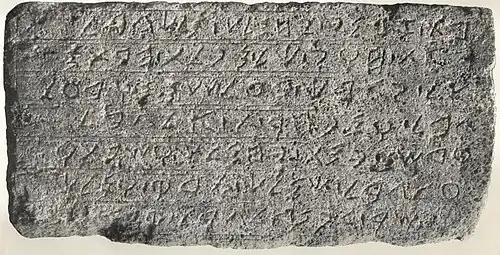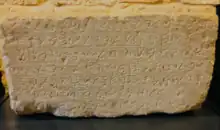Yehimilk inscription
The Yehimilk inscription is a Phoenician inscription (KAI 4 or TSSI III 6) published in 1930.[1][2] Currently in the museum of Byblos Castle.


It was published in Maurice Dunand's Fouilles de Byblos (volume I, 1926–1932, numbers 1141, plate XXXI).[3]
It is dated to the 10th century BCE, and contains the earliest known Phoenician reference to Baalshamin.[4]
The earliest known Aramaean evidence of this god is found around 790 BC in the Stele of Zakkur.[5]
Text of the inscription
BT
Z
BNY
YḤMLK
MLK
GBL
[This is] the temple that he has built, Yehimilk, king of Byblos.
H’T
ḤWY
KL
MPLT
HBTM
/
’L
It was he who restored all these ruins of temples.
WMPḤRT
’L
GBL
/
QDŠM
and the assembly of the holy gods of Byblos—
YMT
YḤMLK
WŠNTW
/
‘L
GBL
[may these gods prolong] Yehimilk's days and his years over Byblos,
K
MLK
ṢDQ
WMLK
/
YŠR
because [he is] a just king and a righteous king
LPN
’L
GBL
QDŠM
[H’]
before the holy gods of Byblos, he.
Bibliography
- Christopher Rollston, "The Dating of the Early Royal Byblian Phoenician Inscriptions: A Response to Benjamin Sass." MAARAV 15 (2008): 57–93.
- Benjamin Mazar, The Phoenician Inscriptions from Byblos and the Evolution of the Phoenician-Hebrew Alphabet, in The Early Biblical Period: Historical Studies (S. Ahituv and B. A. Levine, eds., Jerusalem: IES, 1986 [original publication: 1946]): 231–247.
- William F. Albright, The Phoenician Inscriptions of the Tenth Century B.C. from Byblus, JAOS 67 (1947): 153–154.
- Corinne Bonnet. Existe-t-il un B'l gbl. à Byblos. À propos de l'inscription de Yehimilk (KAI 4). Ugarit-Forschungen, 1993, 25, pp.25-34. ⟨hal-01865311⟩
References
- Maurice Dunand, Nouvelle Inscription Phénicienne Archaique, RB 39 (1930): 321–331.
- "Middle East Kingdoms- Ancient Central Levant States". Kessler Associates. Retrieved 23 May 2017.
- Dunand, Maurice (1939). Fouilles de Byblos: Tome 1er, 1926-1932 [The Byblos excavations, Tome 1, 1926–1932]. Bibliothèque archéologique et historique (in French). Vol. 24. Paris: Librarie Orientaliste Paul Geuthner. and Dunand, Maurice (1937). Fouilles de Byblos, Tome 1er, 1926–1932 (Atlas) [The Byblos excavations, Tome 1, 1926–1932 (Atlas)]. Bibliothèque archéologique et historique (in French). Vol. 24. Paris: Librarie Orientaliste Paul Geuthner – via https://gallica.bnf.fr.
{{cite book}}: External link in|via= - van der Toorn, K.; Becking, B.; van der Horst, P.W. (1999). Dictionary of Deities and Demons in the Bible. Eerdmans Publishing Company. p. 150. ISBN 978-0-8028-2491-2. Retrieved 2022-01-30.
- Herbert Niehr (ed), The Aramaeans in Ancient Syria. Handbook of Oriental Studies. Section 1: The Near and Middle East. BRILL, 2014 ISBN 978-90-04-22943-3 pp.168-169
- Donner, Herbert; Rölig, Wolfgang (2002). Kanaanäische und aramäische Inschriften (5 ed.). Wiesbaden: Harrassowitz. p. I, 1.
- Krahmalkov, Charles R. (2000). Phoenician-Punic Dictionary. Leuven: Peeters / Departement Oosterse Studies. pp. 106, 129, 179, 218. ISBN 90-429-0770-3.